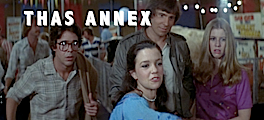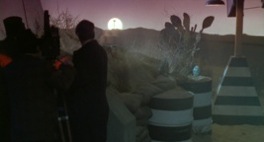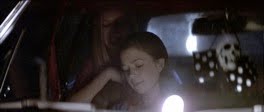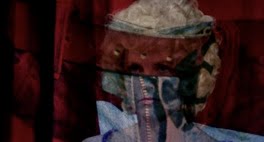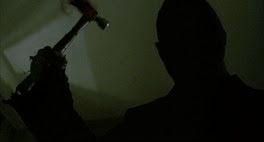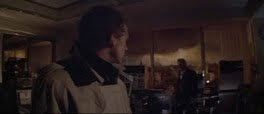 Coming off a pretty uninspiring fiscal haul after a Joel Silver-ushered wide release, Splice, the indie horror prize horse of the 2010 Sundance Film Festival and Vincenzo 'Cube' Natali's newest genre endeavor, should have lit a fire underneath the rear-ends of both the makers and consumers of all the generic studio-horror crap being churned out. Alas, despite a relatively confident ad campaign, selling the flick as a science-gone-amok creature feature, and the Sundance hype, making it out to be a Species shucked of the 90s' anti-nutritive schlock ethos and pressure washed to a 21st century sheen, the film failed to make much waves besides alienating a chunk of the average movie-going public, who I suspect assured themselves of their moral superiority to both the characters and the material - as if we all wrangled corporate shenanigans and were intimate with the volatile depressions of maternal interiority! - and went on their merry way, feeling free to poke at the film's host of flaws and ignore the essentialist tidbits the film's allegory offers. But it's a habit for the general masses to not see through the embellishments of fiction, or never take anything seriously long enough to have it question back at them and what they hold dear. That's especially a problem for Splice, which embellishes to a fault, and asks us with foolish earnestness to consider, for one, sex as a settlement of ownership as much as one of desire (and yes, incredulous movie-goer who insists on never taking Adrien Brody seriously as an actor again: I mean that especially for those of us who don't have a seductive femme-beast prying at our barn doors); or the family as just another potentially corrupted enterprise in people's eternal lust for pride and proprietorship. The film effectively allegorizes the incorporated world of competition and egregiously tidy controlled experiments, where every assault or selfish act can be tied up with cool-as-cucumber justifications about games started, experiments ending, and profit accumulated. Piled onto that, the film is furthermore, and even more so, concerned with the existence of Freudian psychology that is always pulling us in the midst of great mind-expanding progress back to square one.
Coming off a pretty uninspiring fiscal haul after a Joel Silver-ushered wide release, Splice, the indie horror prize horse of the 2010 Sundance Film Festival and Vincenzo 'Cube' Natali's newest genre endeavor, should have lit a fire underneath the rear-ends of both the makers and consumers of all the generic studio-horror crap being churned out. Alas, despite a relatively confident ad campaign, selling the flick as a science-gone-amok creature feature, and the Sundance hype, making it out to be a Species shucked of the 90s' anti-nutritive schlock ethos and pressure washed to a 21st century sheen, the film failed to make much waves besides alienating a chunk of the average movie-going public, who I suspect assured themselves of their moral superiority to both the characters and the material - as if we all wrangled corporate shenanigans and were intimate with the volatile depressions of maternal interiority! - and went on their merry way, feeling free to poke at the film's host of flaws and ignore the essentialist tidbits the film's allegory offers. But it's a habit for the general masses to not see through the embellishments of fiction, or never take anything seriously long enough to have it question back at them and what they hold dear. That's especially a problem for Splice, which embellishes to a fault, and asks us with foolish earnestness to consider, for one, sex as a settlement of ownership as much as one of desire (and yes, incredulous movie-goer who insists on never taking Adrien Brody seriously as an actor again: I mean that especially for those of us who don't have a seductive femme-beast prying at our barn doors); or the family as just another potentially corrupted enterprise in people's eternal lust for pride and proprietorship. The film effectively allegorizes the incorporated world of competition and egregiously tidy controlled experiments, where every assault or selfish act can be tied up with cool-as-cucumber justifications about games started, experiments ending, and profit accumulated. Piled onto that, the film is furthermore, and even more so, concerned with the existence of Freudian psychology that is always pulling us in the midst of great mind-expanding progress back to square one.It's a lot on director-screenwriter Vincenzo Natali's plate, and the range, logic, and precision of his screenplay's escalating turn-of-the-screws and overarching subtext salvage a film with its fair share of cartoonish dialogue, and the gauche aestheticizing all but characteristic of a storyboard-artist-turned-director, or a schooled-in-resourcefulness indie visionary, or a Canadian genre-film director taking after the garish theatricality of Cronenberg without his forebear's charismatic severity and exacting intellectualism.
Natali, the up-and-coming master of the laborious and naifly over-visualized, over-conceptualized genre film, began his career with the impressive but all-too-characteristic Cube. Essentially a film about a bunch of overheated character actors trapped in a bunch of rooms with the occasional gory booby trap, it showed his capacity for open-ended allegory as well as his talent for enhancing interaction between his players in a minimalist setting. Hand in hand, it also exhibited his geek sensibility, and his unerring, almost preening belief in the clean image, the fussily symmetrical one, and the dramatic and graphic sledgehammer. Although he was never one, it sometimes is known as the Music Video Director Disorder, in which a filmmaker begins with the visual concepts and then never diverts, going mach 12 in the ratio of steroidal, tunnel-visioned aestheticism over speed of sound of hot air blowing between their ears. There's a loss of all ability to go smaller, and while a music video may call for that, a full length film achieves its effects by an ability to go big and small, then stagger them at the appropriate times. This is also a symptom of Video Game Movie Syndrome - Natali's next film Cypher often feels like a string of video game cutscenes, and further showed his over-attachment to graphical perfectionism and anti-realist set pieces. His two short films, Elevated and the Paris, je t'aime short Quartier de la Madeleine, both (particularly the latter) suffer from the same feeling of "This is so clever!"-ness that seems to dog Natali's output. He makes "showcase specimen" films, and he exhibits (i.e. executes) his stories with the bombastic preciousness of Carl Denham bringing King Kong on Broadway.
But if there's a reason to be particularly hard on him, it is because his potential for incisive drama, stories that wrestle with challenging, abstracted morals, and a general directorial deftness exists beneath the film school ostentation. Splice finally allows him to work without the crutch of the plasticine eye-poppery of his previous work, as he takes on a straightforward narrative without any of the high-concept mindfuckery.
 The first third or so of Splice threatens the same old geekery for Natali. It takes place primarily in the N.E.R.D. biotechnology lab, N.E.R.D. being an acronym for Nucleic Exchange Research & Development (... riiight. And right away it's quite easy to take the film as overtly comic). The too-cute acronym points to the film as overstated parable, as we see it (and the science-bewitched Natali, who was inspired to write the script for Splice after seeing pictures of MIT's Vacanti mouse, a mouse seemingly with a human ear growing out of its back) pointing out with awkward, self-amused self-deprecation its gleeful fascination with our future where the Scientists Rule the World. Natali films this state-of-the-art nerd workshop with the souped-up flashiness resultant of his sure enough fetish with this commune of world-changing underground geniuses, the Top Secret lab setting a real breeding ground for Natali's one-note visual over-confidence: Everything awash in blue. Data read-outs fill the screen. There's a cheeky "work" montage timed to the hip techno music his young scientists listen to. The camera showily tracks 360˚ with Polley as she circles around her specimen, tapping at a clipboard and looking deep in Scientist-Thoughts. The first shot is a POV of a splice emerging from the uterine depths. This sort of obvious, indelicate visual (and surely very technical) concept work, though, is all the film seems capable of in this first act. But while generic, at least it sets the film's tone properly: Splice is a poppy, not-at-all somber sci-fi/horror parable, involving Polley and Brody playing precocious science wunderkinds and power couple, a delightful Macbeth/Lady Macbeth variation (or Frankenstein/Lady Frankenstein, more accurately). It is their husband-wife relationship (although the audience is let to surmise that "married" they will never be) that soon accepts the disruption of a scientific experiment as a child stand-in.
The first third or so of Splice threatens the same old geekery for Natali. It takes place primarily in the N.E.R.D. biotechnology lab, N.E.R.D. being an acronym for Nucleic Exchange Research & Development (... riiight. And right away it's quite easy to take the film as overtly comic). The too-cute acronym points to the film as overstated parable, as we see it (and the science-bewitched Natali, who was inspired to write the script for Splice after seeing pictures of MIT's Vacanti mouse, a mouse seemingly with a human ear growing out of its back) pointing out with awkward, self-amused self-deprecation its gleeful fascination with our future where the Scientists Rule the World. Natali films this state-of-the-art nerd workshop with the souped-up flashiness resultant of his sure enough fetish with this commune of world-changing underground geniuses, the Top Secret lab setting a real breeding ground for Natali's one-note visual over-confidence: Everything awash in blue. Data read-outs fill the screen. There's a cheeky "work" montage timed to the hip techno music his young scientists listen to. The camera showily tracks 360˚ with Polley as she circles around her specimen, tapping at a clipboard and looking deep in Scientist-Thoughts. The first shot is a POV of a splice emerging from the uterine depths. This sort of obvious, indelicate visual (and surely very technical) concept work, though, is all the film seems capable of in this first act. But while generic, at least it sets the film's tone properly: Splice is a poppy, not-at-all somber sci-fi/horror parable, involving Polley and Brody playing precocious science wunderkinds and power couple, a delightful Macbeth/Lady Macbeth variation (or Frankenstein/Lady Frankenstein, more accurately). It is their husband-wife relationship (although the audience is let to surmise that "married" they will never be) that soon accepts the disruption of a scientific experiment as a child stand-in.And with that, the Freudian drama that essentially makes up the majority of the film emerges. At this point the film morphs completely into a marriage drama and freak-show allegory of the family unit. And with this, our genre showman shows he is capable at wringing out some high drama out of the completely banal and the entirely domestic. Natali shows an awareness of the black comedy at the heart of his film, and it shows in how knowingly he pushes buttons, then how willing he is to mute it all with drollness, in follow-up moments that both ground its outrageous fable and self-analyze its empathy with these characters and their lamentable parenthood. The film has the right idea, taking the sacred values of family - too often artificial ideas of devotion and humility and self-giving - all down a notch once the film enters its scale-size recreation of the Oedipal unit. It slows down and pitches its look at science meat-heads attempting playing house with a perfectly wry tone, from: 1) the wonderfully mundane shot of Wife-Polley seated at the kitchen table giving Husband-Brody the all-too-typical "Sit down now and explain yourself, or I'll burn holes in your head with my eyes" death stare (this immediately, and wonderfully, following the film's most uproarious moment, the line-crossing creature sex scene), to 2) the film's 2nd most uproarious moment (also an awkward sex scene) - a no-brainer Primal Scene by way of a makeshift household the size of a high-tech research lab's equivalent of a janitor's closet.
Once the film enters its increasingly demented, lonely-barn-set second half, Natali increasingly enlivens the proceedings with healthy doses of dripping family gothic and horror movie tropes. It is a devolution from the cleanly technological future to the shivery prickliness of psycho-sexual humanity - a juxtaposition of scientific, asexual rationality, and human dissatisfaction of living one's life entirely in a petri dish or test tube, metaphorically or, in the hybrid Dren's case, literally.
The climax is a commercial concession that doesn't really take away from the moral tale it told previously. It is grand guignol perfection, acknowledging that the hellish climaxes of horror tradition, throughout the ages, is what narrative orthodoxy says happens when humanity in its very condition has failed itself. The salvaging irony of the film's vindictive, shit-hits-the-fan finale is that it isn't Clive and Elsa's "playing God" that makes them deserve it, but their "being human" - that is, the very human paternal/maternal psycho-sexual transgressions they just acted out, wham-bang, one right after the other. And between this and the hellish finale is the devious lull where Dren tragically passes and the two think they got away with it. After what they did, they mourn Dren like any other parent outliving their child, pretending they didn't know all along that this injustice of a short life lived painfully would surely be the outcome. If the film ended there, the film would feel complete - an amoralistic tale of a hyper-lived parenthood by two very very bad parents. But the film's realized ending is one that insists on doling consequence, and, even through its transparent nature as a gleeful gothic set-piece, it is all perfectly qualified as the bitter, tragic ironies of it all shine through. Science to take seriously goes completely out the window (so, does the tail/stinger/penis exist in nature?), yes, but that's probably a threshold the film had long surpassed, as the film is generally ridiculous and already has made it a striking, absurdist structural point to have Dren - on at least two separate occasions - surprise us with unknown organs and appendages, implying a sort of genetic "perfection"; Dren as a scientific miracle of limitless power and freedom... yet, that somehow always ends up getting its wings clipped.
 The film has a consistent way of stepping on its toes, though. For every staid dramatic sequence or baroque cinematographic chill, we are treated with a groaner about Polley's mother, or the dance scene and de-stinging scene, which are staged and hyper-actively directed in a way akin to a toddler with crayons trying to draft like da Vinci. The film's use of biological sex change seems to be a bit of cookie-cutter, fear-baiting "weird science," its use as a pat explanation for sudden animalistic aggression (in both the case of Dren as well as Ginger & Fred) seeming anti-constructive to the film's undercurrent of females in power roles. We have three in this film: Polley's Elsa, who harbors the social instinct to never have a baby biologically, for the fear of her body being owned by either her boyfriend or her baby (at odds to her very male desire to propagate her prided genetic identity); Dren, whose genetic perfection is useless in the face of an existence characterized by a non-ownership of her own life and the impossibility of attaining a social/sexual being; and the female CEO of the pharmaceutical company, who wisely must have kept any personal longings out of her professional matters to have gotten so far (and has thus dodged oppression, in regards to gender-politics if not socio-politics, anyway). If the film's milieu nicely makes viewers grapple with any pathetic anxieties about females being in charge and fulfilling their potential through a gender neutralizing view of science and sex (and the film's Electra moment is as much about gawky sexually-repressed Daddy as it is about koo-koo socially-oppressed Mommy), then what to make of the film, twice-over, deigning feminine sexuality - feminine dominance - as something for those genetically equipped creatures to just shuck off for some "truer" sort of natural, particularly masculine dominance? The best defense I can give for this is that the film, gives an Antichrist-like deconstruction of patterned gender roles as they are, constructed and only solidified by the historical precedent humanity has established. After all, Dren's incestuous rape of Elsa is the accumulation of all the transgressive acts previously done towards her: maiming, sexual gratification, and whatever Freudian emotional connections are desired to be made from claiming someone as your own to do whatever you want with. This gives a little more justification to the film's tasteless, oft-scorned reprise of Elsa's "Inside you" late in the film as a sort of wishful incantation inherent to the human spirit even at its most bestial. But this leads to some conflict in the film's internal philosophy, for the film sets itself up mostly as a testament to the ineluctable declensions humanity is vulnerable to due to our most basic and natural human urges - less about the harmfulness of our constructions, which, given the film's sympathies toward its grand construction Dren, is something Natali associates with progress, not perversity, as Von Trier in his film.
The film has a consistent way of stepping on its toes, though. For every staid dramatic sequence or baroque cinematographic chill, we are treated with a groaner about Polley's mother, or the dance scene and de-stinging scene, which are staged and hyper-actively directed in a way akin to a toddler with crayons trying to draft like da Vinci. The film's use of biological sex change seems to be a bit of cookie-cutter, fear-baiting "weird science," its use as a pat explanation for sudden animalistic aggression (in both the case of Dren as well as Ginger & Fred) seeming anti-constructive to the film's undercurrent of females in power roles. We have three in this film: Polley's Elsa, who harbors the social instinct to never have a baby biologically, for the fear of her body being owned by either her boyfriend or her baby (at odds to her very male desire to propagate her prided genetic identity); Dren, whose genetic perfection is useless in the face of an existence characterized by a non-ownership of her own life and the impossibility of attaining a social/sexual being; and the female CEO of the pharmaceutical company, who wisely must have kept any personal longings out of her professional matters to have gotten so far (and has thus dodged oppression, in regards to gender-politics if not socio-politics, anyway). If the film's milieu nicely makes viewers grapple with any pathetic anxieties about females being in charge and fulfilling their potential through a gender neutralizing view of science and sex (and the film's Electra moment is as much about gawky sexually-repressed Daddy as it is about koo-koo socially-oppressed Mommy), then what to make of the film, twice-over, deigning feminine sexuality - feminine dominance - as something for those genetically equipped creatures to just shuck off for some "truer" sort of natural, particularly masculine dominance? The best defense I can give for this is that the film, gives an Antichrist-like deconstruction of patterned gender roles as they are, constructed and only solidified by the historical precedent humanity has established. After all, Dren's incestuous rape of Elsa is the accumulation of all the transgressive acts previously done towards her: maiming, sexual gratification, and whatever Freudian emotional connections are desired to be made from claiming someone as your own to do whatever you want with. This gives a little more justification to the film's tasteless, oft-scorned reprise of Elsa's "Inside you" late in the film as a sort of wishful incantation inherent to the human spirit even at its most bestial. But this leads to some conflict in the film's internal philosophy, for the film sets itself up mostly as a testament to the ineluctable declensions humanity is vulnerable to due to our most basic and natural human urges - less about the harmfulness of our constructions, which, given the film's sympathies toward its grand construction Dren, is something Natali associates with progress, not perversity, as Von Trier in his film.'Splice' - 6/10
Spot-on Reviews:
Cinepinion on Splice
The Pinocchio Theory on Splice
Annalee Newitz on Splice
makesomelove on LiveJournal on Splice




















